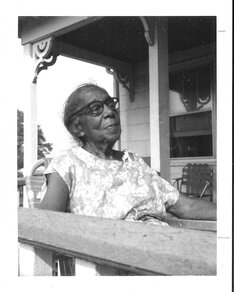 Catherine Johnstone Hopkins, lovingly called “Miss Katie”, was born in the Grove neighborhood of Laurel, in 1906. Her parents were Elizabeth and Frank J. Hopkins. The surname is suspected to have been given from ancestral enslavement.* Miss Katie was one of only two children. Her sister Ethel died just seventeen days before her 100th birthday and Miss Katie lived in Laurel for all of her 105 years. She attended day and night school in Prince George’s County and was taught piano lessons from Mrs. Dora Mack Carter, of the entrepreneurial Carter family of Guilford, MD; the first black woman to provide private music lessons in Howard County and own a country music studio. Miss Katie grew to share her talent as a singer, during the 1940s, in the Union Gospel Chorus, a local community band and as the organist and pianist, 46 years in service to St. Mark’s Church, for which she received recognition. During her early years of employment, she worked with children at the St. Mildred’s Academy; known today as St. Mary of the Mills School. She later worked as a seamstress at Ft. Meade, during WW II, a job for which she expressed a lot of love and enjoyment.
Thereafter, she was employed at the University of Maryland for many years. Through her retirement in 1973, Miss Katie worked at the O.W. Phair Elementary School, which was located at 1100 West Street (intersecting with Park Avenue). The school ceased operation around 1979 and was later renovated and used for temporary WSSC offices in the 1980s. Prior to the passing of Miss Katie and her sister Ethel, both sisters were featured in a 1983 Laurel Leader article**, where they described remembering when there was an oak grove in the Grove community, named for the stately, shady trees. They also recalled when the streets were dirt roads and the sidewalks were wooden boardwalks. Photograph and information pulled from the Laurel Museum Collection. Updated~Laurel Historical Society/AVF2021 *In 2020, new evidence showed that Johns Hopkins claimed four men as his property on the 1850 Census and often had business dealings using Black people as collateral). https://www.washingtonpost.com/opinions/2020/12/09/johns-hopkins-university-founder-enslaved-people/ **The Grove: Rooted in a Proud Tradition.” Laurel Leader, September 1, 1983 CLICK HERE FOR THE PDF VERSION OF THIS POST.
0 Comments
 Bertha Levi Moore arrived in Laurel at 11 months old. She attended the first “Colored School #2”, located at 803 West Street, with 54 other children and a single teacher. When she became of high school age, Laurel High School was open to white students only. Bertha boarded with a family in Washington, DC to attend high school classes offered by Howard University. Bertha would herself become a school teacher and teach at the “Colored School #2” where she was first educated. She settled in Laurel, eventually marrying. She and her husband built a house on 10th Street and were considered “Blockbusters”, as the first African Americans to reside on that block. They farmed their plot of land and sold their produce, while raising 13 children. Bertha’s accomplishments were significant, as she was the daughter of slaves. Her father escaped slavery and eventually joined the Union Army to fight in the Civil War. Her mother would have been considered fortunate, at the time, learning to read and write from white teachers traveling from the northern states to give free lessons to black children. Her mother’s last name was Hall, suspected to be named after the Hall family, to whom she was enslaved. They lived in a small African American town off Rte.197 in Laurel called Halltown. In the 1890s, Bertha’s parents were among the earliest members of St. Mark’s church, still thriving at 601 8th Street.
During an interview in the 1970s, Bertha shared memories of the Laurel Sanitarium for mental illness and the Keely Institute for the treatment of alcoholism as being the primary employment for African Americans at the time. Prior to its relocation to the grounds of the Laurel Sanitarium, the Keely Institute was located at 5th and Talbott Streets, which was the dividing line between the black and white communities. She recalled memories of the local chapter Ku Klux Klan burning crosses at Ivy Hill Cemetery and near St. Mary of the Mills Church on 8th Street. Photograph and information pulled from the Laurel Museum Collection. Updated~Laurel Historical Society/AVF2021 CLICK HERE FOR THE PDF VERSION OF THIS POST |
AuthorContributions by Laurel Historical Society staff and volunteers. Submissions welcome! Archives
August 2022
Categories |
LAUREL HISTORICAL SOCIETY
History & Happenings Blog
Home
|
Site Map |
Laurel Historical Society
817 Main Street Laurel, MD 20707 301-725-7975 [email protected] Laurel Museum Hours: Friday - Sunday 12-4 pm Research and Tour groups by appointment. |
© COPYRIGHT 2015-2023. ALL RIGHTS RESERVED.
 RSS Feed
RSS Feed

